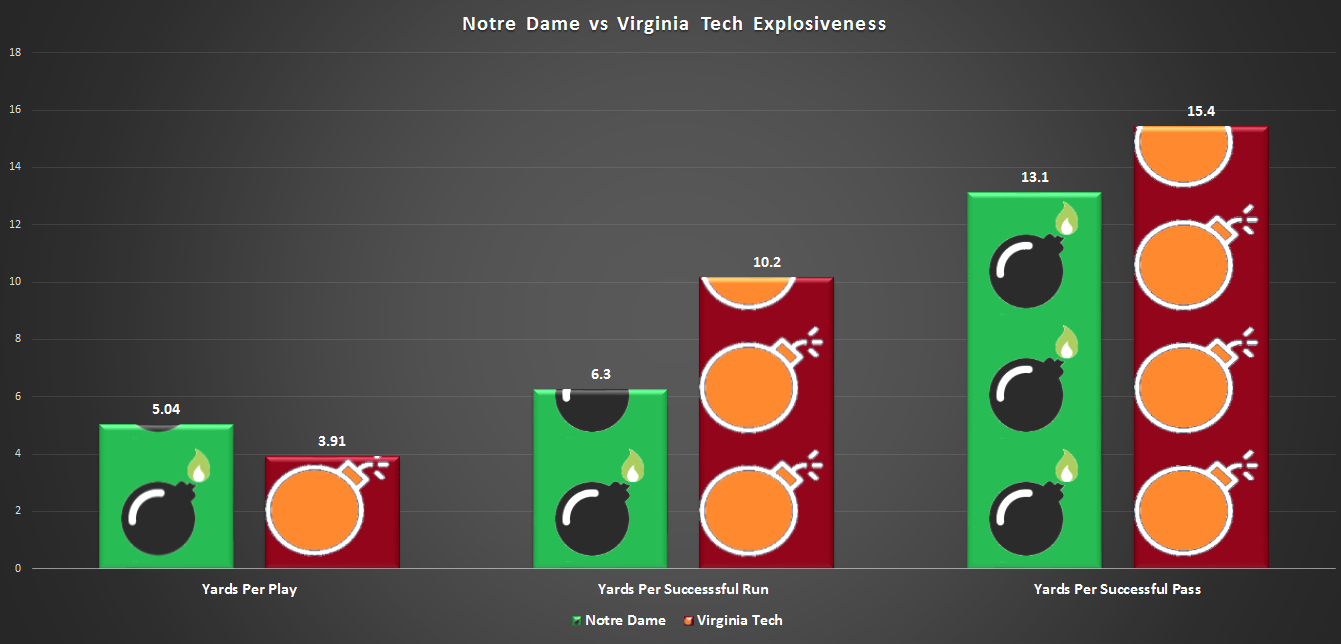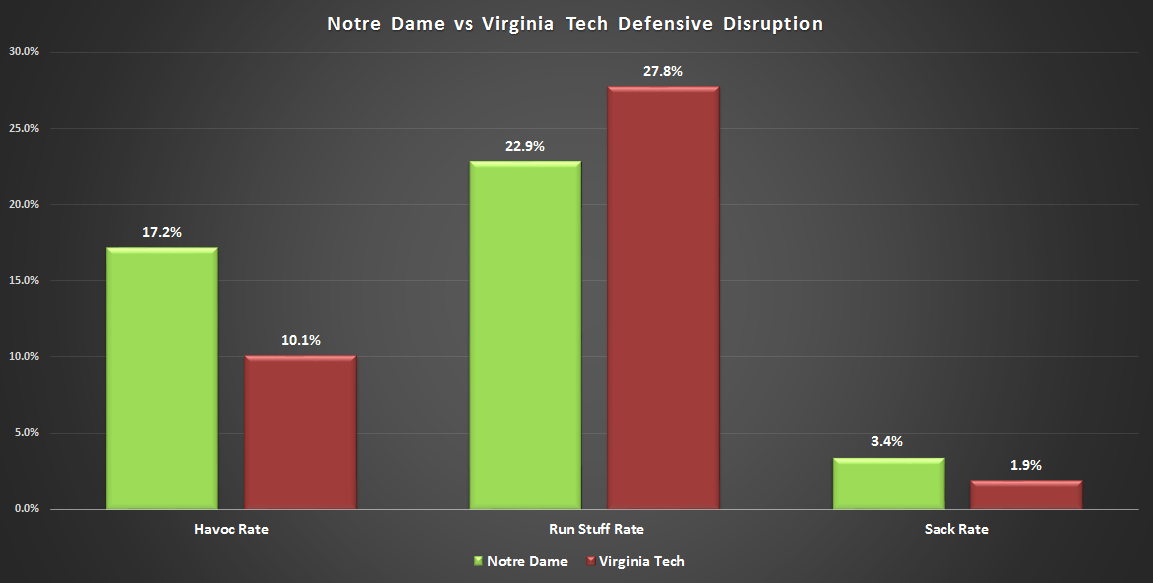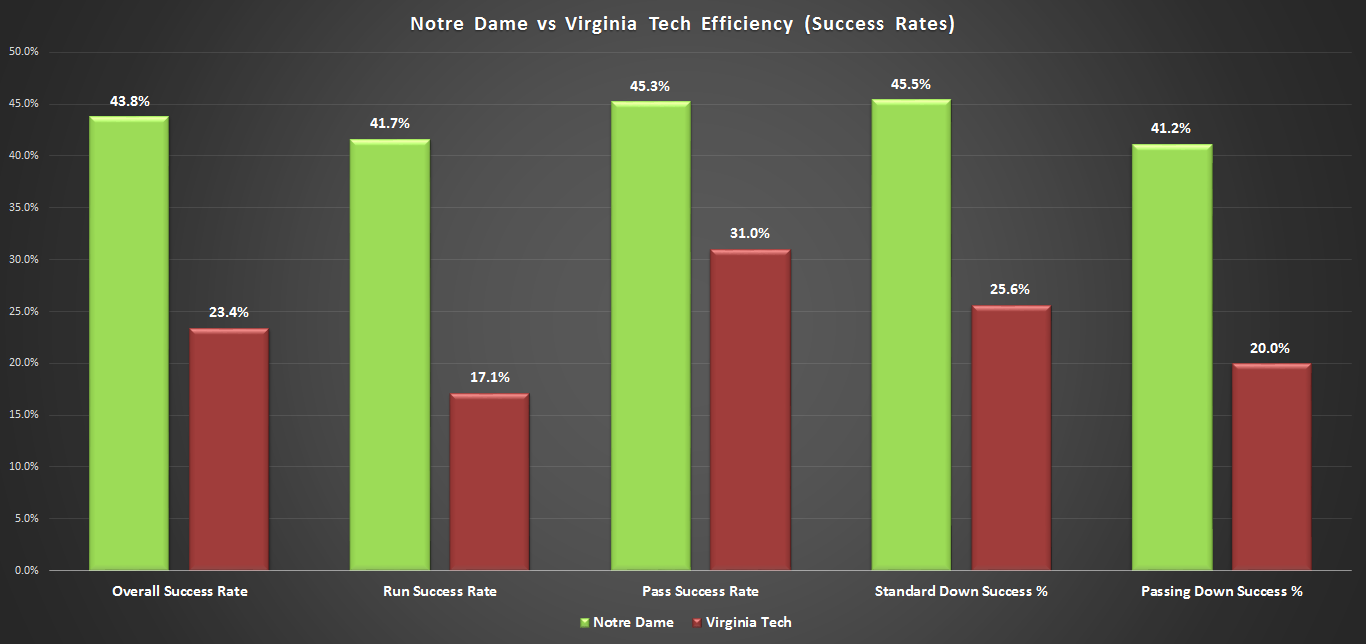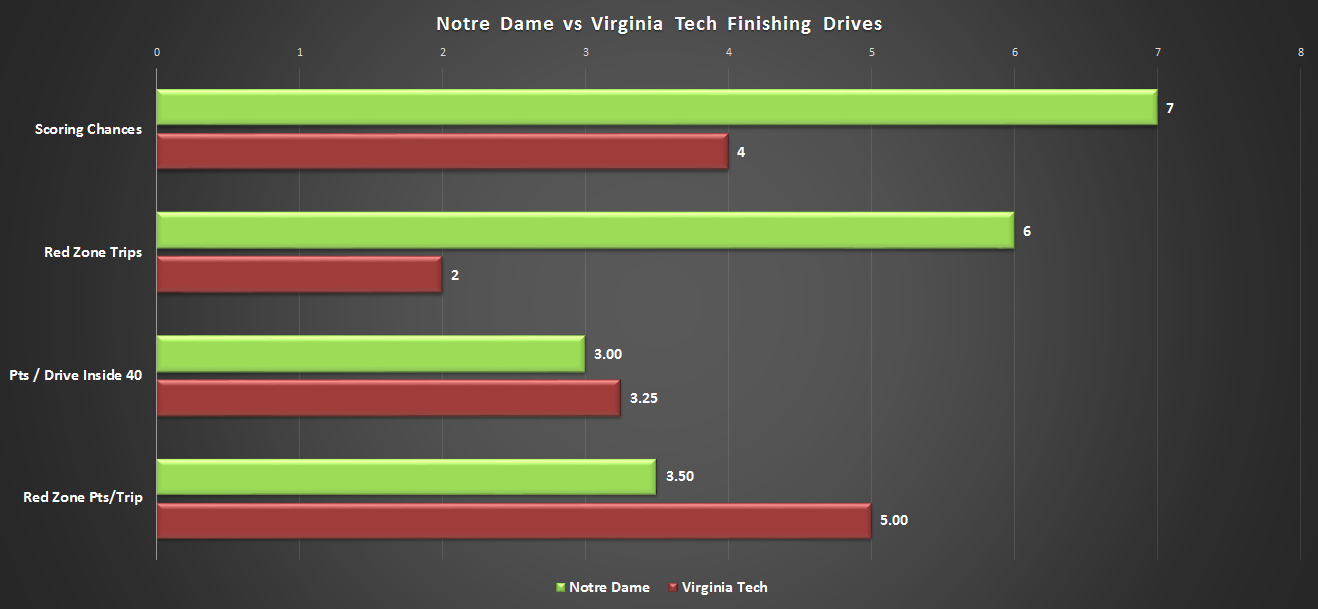Notre Dame dominated the Hokies in the most important categories that decide games, but the Irish shot themselves in the foot in all of the less predictable and more random facets of the game. Turnovers and special teams blunders that cost valuable field position nearly led to a horrendous loss reminiscent of South Florida loss in 2011.
It took the Irish an incredible two-minute drill led by Ian Book to come from behind for the win, but SP+ looks at the more predictive final stats only and gave ND a 99% win expectancy*! You can spin this into a positive or a negative view. On one hand, it’s encouraging that the Irish significantly outplayed a so-so and one-dimensional Virginia Tech team in the most sustainable phases of the game. On the other, after a horrendous loss in Ann Arbor the mistakes continued to pile up and nearly led to a disastrous home loss.
The reality, as usual, is somewhere in the middle. But you have to commend a flawed team with mounting injury losses scratching out this win with so much going against it. Dealing with loads of criticism and likely a little self-doubt coming out of the horrific loss at Michigan, costly injuries continued to pile up, and the worst possible play in football happened again to the home team in Notre Dame Stadium. It was, for lack of a better term, a ballsy effort by Book and his teammates that was uncomfortable throughout but keeps a ten-win season and New Year’s Six bowl on the table.
Something not clear? Check out this handy advanced stats glossary.
*Note that this post-game win expectancy is very different from the squiggly line in-game win probability charts that look at scoring margin and down/distance and team quality and produce an estimate. In fact, it disregards points and views only at the final team stats and more heavily weighing the most predictive attributes like explosiveness and efficiency. This produces an estimated win % of how often a team should have won the game based on less random and predictive elements of the game. To lose with a very high win expectancy requires some mix of turnovers and bad turnover luck, special teams blunders, penalties, and failure to convert scoring chances.
Zero garbage time plays in this tight contest but as always kneel-downs and end of half possessions are not included.
Explosiveness

Brian Kelly’s team outgained the Hokies by +1.14 yards per play, an advantage closest to the Louisville game this season (ND was +1.29 YPP) but with a different tone. In the first half, the Irish edge was +2.75 YPP with a 45.5% success rate compared to just 17.6% for Virginia Tech. The ND defense forced three-and-outs on six of eight Hokie possessions. To somehow enter the locker room at halftime tied requires a nearly impossible confluence of mistakes and bad luck, which the Irish managed to provide mainly with two red zone turnovers.
It doesn’t take a Ph.D. in statistics to know this, but the Jafar Armstrong fumble at the one returned for a VT touchdown is the costliest play in football and warps the statistical fabric of the game. Notre Dame went a 3rd and goal from the 1 situation where the team’s expected points statistically are just below six to losing seven points in one play. The odds of this play happening at home three times in nine seasons has to be in the realm of lightning striking someone three times, yet it’s a one to add to the lowlight reel with USF and USC in 2011.
The second half was much closer in yards per play thanks to an edge in explosive plays for Quincy Patterson and the Tech offense. The Hokies had just nine successful pass plays in the game, but two combined for 78 yards. Both long gains created scoring chances that fortunately the Irish defense held the field goals.
Offensively it remains all on Ian Book and the passing attack to manufacture big plays because there’s simply nothing breaking out on the ground. The longest run of the game was a 13-yard Book scramble, marking the fourth time this season (Louisville, Georgia, Michigan) that has been the case. If you look at this game and Notre Dame’s two losses, there’s just three runs by running backs that gained more than 7 yards across the three games. The dominant rushing attack against USC feels like a distant memory at this point, and with Robert Hainsey injured early to add to Tony Jones Jr. and Tommy Kraemer out, the Irish feel incredibly thin running the ball.

Notre Dame’s defensive disruption has leveled off after a red-hot start to the season. The Irish posted havoc rates well above average in three of their first four games, highlighted by the dominant second half versus UVA. Since then the Notre Dame defense has been below average in the four games since – maybe due to playing two of the more dangerous receiver groups and missing a healthy Shaun Crawford. The ND front seven had a solid run stuff rate against a run-heavy Hokie attack, but Bud Foster’s defense put up an even higher rate. It’s a red flag worth monitoring as the high stuff rate allowed by Notre Dame running the ball in 2018 was an Achilles heel that preventing the offense from running efficiently, especially last November.
Efficiency

Historically a team with a success rate advantage of 20-30% wins about 99 games out of 100 with an average scoring margin of +31.6 points. The Irish were on the low end of that band but definitely drove down that average edge in points and very nearly ended up in the 1% of teams that fail to win this type of game.
Offensively Notre Dame was consistently efficient across different types of plays but took a pass-heavy approach to get there. Notre Dame passed the ball on 56% of early (1st and 2nd) downs and inflated success rates converting a lot of short distances to gain, as evidenced by averaging just 6.3 yards per successful run. Pass plays averaged 6.43 yards against just 3 yards per rush attempt for Chip Long’s offense, and with the offensive line injuries and beat up running backs I’d expect the lean towards the pass to continue.
This was Book’s second-highest performance in yards per pass play against a P5 opponent this year yet it would have been his lowest regular-season YPA in 2018, which says a lot. Despite the interceptions and inconsistency, I liked what I saw from Book in this game. He appeared more decisive than in previous games and played with an edge, throwing downfield and giving receivers chances even if those throws weren’t always great. The offense continues to put a ton on his shoulders without much of a running threat and reaching the red zone six times should have been enough to put up plenty of points.
Book heavily targeted his top playmakers, though none of them were very efficient overall when you factor in the volume of looks they saw come their way. Chase Claypool had a career-high 18 targets (6.6 yards/target), Chris Finke had 11 (5.1), and Cole Kmet saw 9 but was a victim of some missed connections for big plays (3.5). The looks for Claypool and Kmet seem by far the best offensive plays right now, but opposing defensive coordinators know that too and aren’t making things easy.
Finishing Drives, Field Position, & Turnovers

This is where things fell apart for the Irish, and I apologize for jinxing it last week by advocating for Notre Dame to now aim for being red zone national champs. After scoring on 100% of previous red zone visits the Irish converted just 50% against the Hokies including two turnovers. To come away with so few points on each scoring opportunity in a game where the Virginia Tech offense clearly wasn’t a threat to go for much more than 20 points was heartburn inducing.
Notre Dame did win the field position battle by seven yards, starting on average at their 30 versus the average Hokie drive starting at their 23-yard line. It should have been an even greater edge though, and that doesn’t include the fumble return for a touchdown which in essence is like staring a drive at the opponent 100-yard line. Jay Bramblett averaged just 38.8 yards per punt and an Irish 4th quarter drive started on their own one after Lawrence Keys’ neurons misfired in a very bad way on a kickoff return.
Teams that lose the turnover battle lose 73% of the time, and Notre Dame tried very hard to use giveaways as a way to squander all the other advantages they built in this game. On average turnovers are usually worth something like five points, but all three for the Irish came inside the Virginia Tech 35-yard line and were worth much more. The analytics would also tell us that Ian Book was really unlucky – the only two pass break ups credited to VT defenders were interceptions.
On to Duke
The Michigan debacle (for good reason) casts such a dark shadow on the season and reaction to this game. As the near-loss was unfolding there was all kinds of calls for a next coach, offensive coordinator, special teams coach, and quarterback. And even after the game some of that discontent has lingered, even if some faded with time. Imagine how this game might be reframed with a close win in Ann Arbor last week – a gritty, hard-fought win even though so much went wrong in the mold of Pitt 2012 or Pitt 2018. It doesn’t matter, we escaped with the win would be the prevailing sentiment, instead, it’s so much gloomier.
One thing that struck me after the game was the difference in performance this season versus 2018 in what the Irish have gotten out of their top players. For reference, here was the top 10 preseason list from the Notre Dame beat before last year’s 12-0 regular season:
10. DE Khalid Kareem: took a major leap, was a stud at the kind of “all-conference” level a step below All-American but extremely solid
9. WR Miles Boykin: excelled in the WR1 role and unexpectedly became a Day 2 draft pick
8. DE Daelin Hayes: may drop a few spots in a post-season ranking but had a strong pass-rushing season despite getting passed by Julian Okwara
7. OL Alex Bars: was terrific before an injury, did miss the second half
6. QB Brandon Wimbush: didn’t quite work out but didn’t lose a game and you could easily sub Ian Book into the 6th best performer spot last season
5. LB Drue Tranquill: was a stud, probably “all-conference” level like Kareem
4. CB Julian Love: Thorpe award finalist, was terrific all year
3. C Sam Mustipher: maybe the biggest disappointment on this list? Was fine but certainly top-10
2. DT Jerry Tillery: had a strong case for the #1 spot post-season and became a future 1st round pick
1. LB Te’von Coney: had an excellent year, even if he maybe wasn’t Notre Dame’s best player
That’s a pretty high hit rate, with seven of ten really playing well. It also didn’t include breakout contributors like Alohi Gilman (12), Dexter Williams (19), and Julian Okwara (20).
This year it feels like there’s a lot more bad luck and underachievement:
10. TE Cole Kmet: has played at an All American level, but the inconsistency of the passing attack has prevented him from making as big of an impact (4.5 receptions / 53 yards per game)
T8. WR Chris Finke: has disappointed in the passing game with just one touchdown against New Mexico
T8. OT Liam Eichenberg: very solid this season as the OL has been good in pass protection but underwhelmed on the ground
7. S Jalen Elliott: not bad but doesn’t feel better than a season ago with higher expectations – maybe because like others, he is being asked to do more?
6. CB Troy Pride: has been fine but the drop-off from Julian Love as CB1 is significant and that domino effect to CB2 and CB3 has been problematic
5. WR Chase Claypool: lived up to his rating and has been Notre Dame’s best offensive weapon
4. S Alohi Gilman: is being asked to do a ton and is handling pretty well but not made some of the impact plays of 2018
3. DE Khalid Kareem: has built on his strong season a year ago
2. QB Ian Book: has seen his pass efficiency and yard per attempt fall off versus last season
1. DE Julian Okwara: had a nuclear game against UVA but not registered the sacks expected
I really only feel great about three of those guys living up to what I’m sure the Irish hoped for entering the season. Additionally, the guys at 11-14 have all faced injuries and have missed / will miss serious time (in order, Jafar Armstrong, Robert Hainsey, Tommy Kraemer, and Daelin Hayes). It really places a lot of pressure on the guys listed above to step up over the last four games to keep the dream of a third straight 10-win season alive.




Good article, Michael, but I know it wasn’t Jafar Armstrong who had the brain fart on the KO return that stuck ND at the 1 in the 4th quarter (was it Braden Lenzy?).
Keys
got it, thanks, I missed that one real-time and fast-forwarded through the replay and review, fixed.
Great article — these are always a nice read for breaking things down. One question — can you go into more detail about your comments toward the end regarding some players like Elliot and Gilman being asked to do more? What additional things are they doing? Are they being asked to do more because other upperclassmen were the ones doing more last year (e.g., Tranquil)? Are they being asked to pick up the slack for others? Just curious to hear more about this
I’m by no means the X’s and O’s expert but I think they’ve tried to cover other relative weaknesses or positions of uncertainty at times with the strengths of the safeties. Both have played more man I think this year and against USC, for example, Gilman was man to man against the slot, sometimes playing like an LB in the box, and other times providing coverage over the top to bracket Pittman.
Last year I think they were freer to cover over the top and then use their instincts to crash down effectively. You had a ton of confidence stopping the run with an elite DT like Tillery + two great run stoppers in Coney + Tranquill. There was also a ton of faith in Love + Pride as a corner combo that I think doesn’t exist at present with Pride + the CB2 of choice between Vaughn, Bracy, and recovering Crawford.
“If you look at this game and Notre Dame’s two losses, there’s just three runs by running backs that gained more than 7 yards across the three games.”
Gross.